Learn facts, figures, and trivia about the world of chameleons
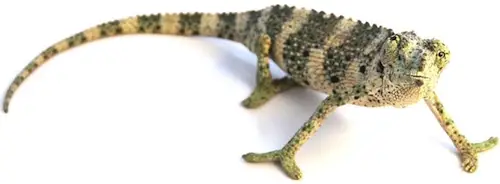
Chameleon facts
Chameleons are totally unique reptiles and come in a variety of sizes, shapes, temperaments, and colors. Perhaps more diverse than any other type of lizard, they deserve a lengthy discussion. Below I’ll provide some interesting facts and figures about chameleons.
- It’s a myth that chameleons can change their colors to match their surroundings. Color change is primarily based upon mood. The more stressed they are, the more colorful they are. It’s called “firing up” their colors in the hobby.
- There are over 160 different species of chameleon, around half of which are found only on the island of Madagascar.
- Chameleons are primarily arboreal, which means they spend their time in trees. However, there are a few ground-dwellers (terrestrial) species.
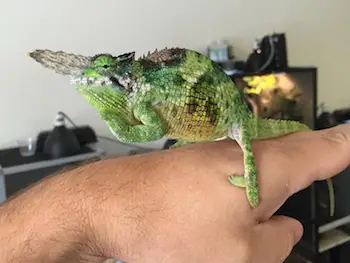
Here’s a Fischer’s chameleon (Kinyongia multituberculata)
on my hand. This species is in fact one of the best pet
chameleons when you can find them available.
- Chameleons are members of the iguania suborder, along with iguanas, agamas, etc. Their family is chamaeleonidae.
- They are found mainly on the continent of Africa, but a few are endemic to Southern Spain, the Middle East, Southern India, and Sri Lanka.
- Most chameleons lay eggs, but a few give live births, including Jackson’s, Werner’s, Mt. Meru, Rudis, and more.
- They don’t have sharp teeth, and they’re the only reptiles that chew their food. How polite!
- They are usually avoided by Malagasy locals in Madagascar as it’s believed chameleons bring bad luck. Stepping on a chameleon in the leaf-litter is bad luck as well—this would be the Brookesia species.
- Chameleons change color using layers of skin cells (chromatophores), the top layer being transparent.
- They have prehensile tails, which is helpful when they’re navigating trees and reaching for branches.
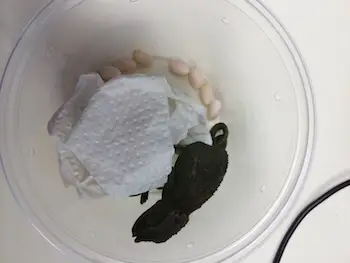
This Dwarf Fischer’s chameleon (Kinyongia tavetana)
arrived to me from a supplier just like this—eggs and all.
Fact: the eggs hatched!
- The word “Chameleon” is comprised of the Greek words “chamai” which means “on the ground or earth” and “leon” which means “lion.” Put them together and you’ve got yourself an “earth lion.”
- Chameleons are diurnal (active during the daylight hours).
- They are very slow and deliberate movers, with a generally docile demeanor. These are definitely not desert swifts!
- There are no native chameleons in North, Central, or South America. There are, however, transplanted populations in Florida, California, and Hawaii.
- A chameleon’s tongue can be nearly twice as long as its body, and it’s extremely accurate.
- Their cone-shaped eyes move independently of each other, so they can observe two things at once. This gives them a 360-degree view, which comes in handy when they’re on the lookout for prey, or predators. When prey is spotted, they’ll focus both eyes on the target, and will usually shift their head back-and-forth repeatedly. This is how they calibrate the distance for an accurate tongue-shot. If this seems odd, try covering one of your own eyes and having someone throw a baseball to you—it’s nearly impossible to catch because you lose our depth perception. You need two eyes to properly calibrate distance, speed, and movement.
- According to National Geographic, a chameleon’s tongue can accelerate from 0 to 20 fps (feet per second) in approximately 20 milliseconds (that’s 20 millionths of a second). It’s so fast, they claim, that it actually defies the principles of muscle power.
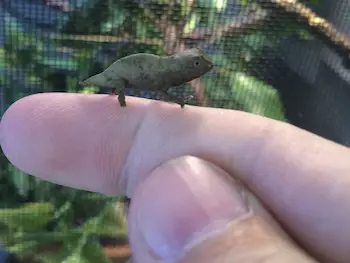
A baby Bearded Pygmy chameleon (Rhampholean brevicaudatus)
that I hatched-out recently. Cool fact: they’re called “Bearded”
because they have a tiny beard-like skin tag on their chin.
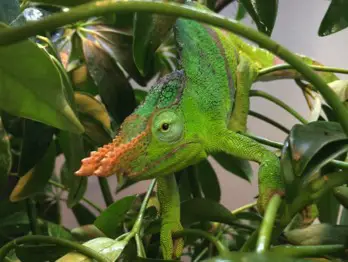
Here’s a rarely seen Giant Fischer’s chameleon (Kinyongia matschiei).
This specimen arrived on an imported shipment but was initially
misidentified as another species of Fischer’s.
- Chameleons have varied lifespans, with some around two years (tiny species), and some over 20 years (larger species). On average, based upon my own experience with them, the average lifespan for some of the most commonly available species is around 4-6 years. This would include Jackson’s, Veileds, Oustalet’s, and more.
- Live plants in a chameleon’s cage help increase humidity. Humidity is very important for their overall health and well being.
- Chameleons vary in length based upon the species, ranging from adult-sizes of 2-inches to around 30-inches, and their lifespans seem to correlate to their overall size.
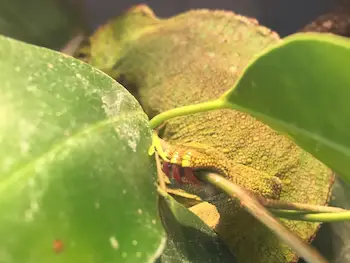
Here’s a snapshot of a red-clawed Four-horned chameleon
I received on a shipment from Cameroon. The red claws
are indicative of Trioceros quadricornis gracilior, which
is pretty rarely seen in the U.S. pet market.
It’s easy to imagine them in your mind, but seeing one in person changes everything. Whenever I hold a live roach or cricket in my fingers and allow one of my bigger chameleons to shoot its long tongue out in a blur to snatch it from my fingers, they are left awestruck.
I hope you enjoyed reading my list of chameleon facts as much as I enjoyed writing it! They never cease to amaze me, and I continue to learn more about them with each passing week. If you’ve got any facts or figures you’d like to recommend I add to this list, please contact me and I’d be happy to do so.
